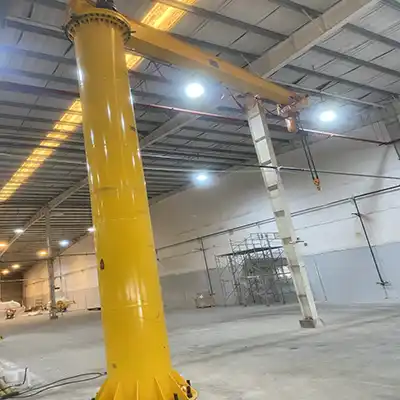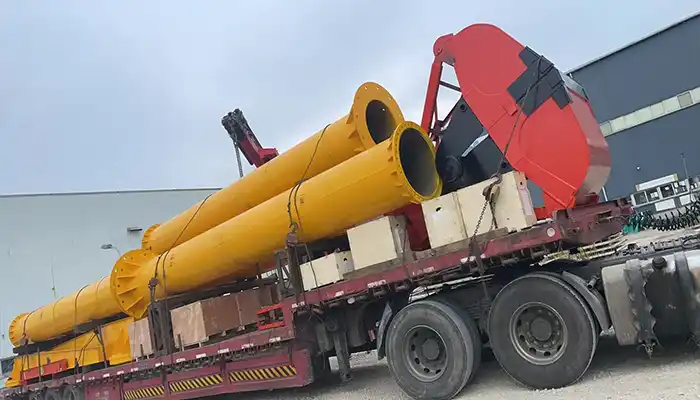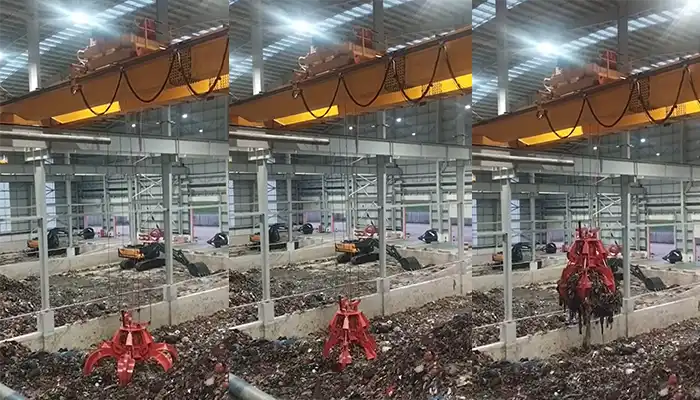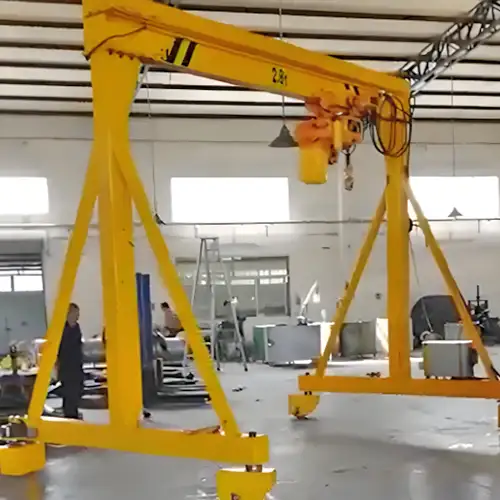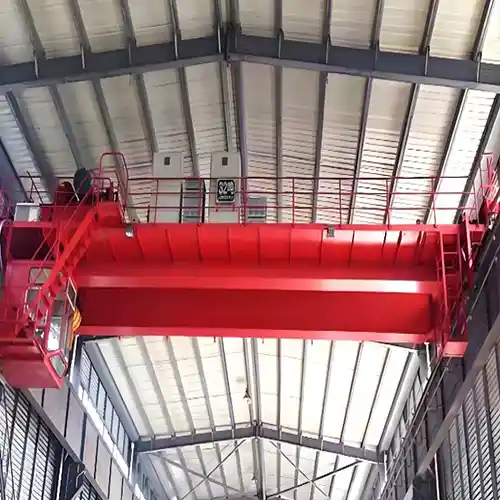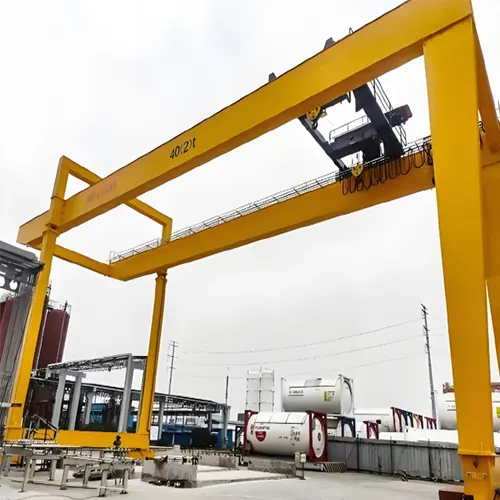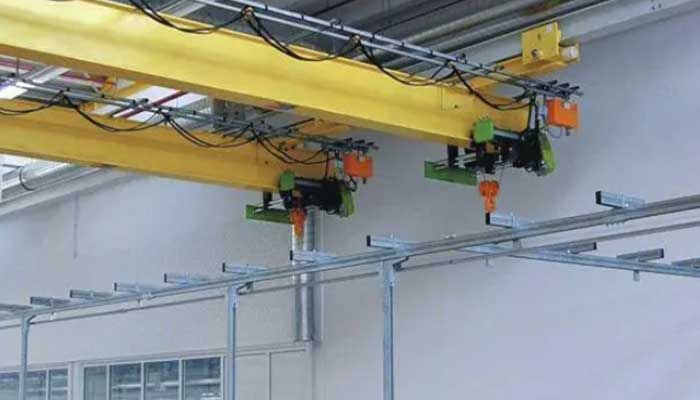
Explosion-Proof Overhead Crane for Flour Mill, Safe Crane Design
Explosion proof overhead cranes for flour mills. Explosion proof crane design, custom explosion proof bridge crane components to ensure flour mill safety.
Explosion-Proof Overhead Cranes for Flour Mills: Design and Safety Features
Flour milling is an industry of both economic significance and critical importance in the food supply chain. However, it operates in an environment where the presence of combustible flour dust poses a unique safety challenge. In this context, explosion-proof overhead cranes have emerged as indispensable tools. This article delves into the design features and safety considerations associated with the use of explosion-proof overhead cranes in flour mills.
Flour Mills and Flour Dust Explosions
The flour milling industry is the foundation of a myriad of food products. It is responsible for transforming grains into the vital ingredient that forms the basis of countless culinary creations. Flour mills supply the food industry with a key component, and their operations are essential for the global food supply chain.
In the dynamic world of flour mills, material handling is the linchpin that ensures the efficient flow of raw materials, the maintenance of equipment, and the transportation of the finished product. However, this industry operates in an environment where safety and efficiency must coexist. Achieving this balance is challenging but crucial.
The core focus of this article is to delve into the specialized world of explosion-proof overhead cranes in flour mills. These cranes are designed to operate safely in environments where combustible flour dust is present. We will explore the design features and safety considerations that make these cranes a vital component of the industry's safety and efficiency paradigm.
The Risk of Combustible Flour Dust
Conditions Leading to Dust Explosions
Flour dust, when suspended in the air in sufficient concentrations, becomes a potential explosion hazard. Several conditions can lead to the ignition of this dust:
- High Dust Concentrations: Dust accumulates in confined spaces, such as ducts and equipment, creating conditions for ignition.
- Ignition Source: The presence of an ignition source, such as electrical sparks, hot surfaces, or open flames, can trigger an explosion.
- Oxygen: Flour dust, when mixed with air in the right proportion, creates an explosive atmosphere. Adequate oxygen levels are necessary for combustion.
Consequences of Flour Dust Explosions
Flour dust explosions can have severe consequences for both personnel and the facility:
- Property Damage: Explosions can cause extensive damage to equipment, structures, and the mill itself, resulting in substantial financial losses.
- Loss of Life: Dust explosions can lead to injuries and loss of life among mill workers and responders.
- Disruption of Operations: Explosions result in downtime and disrupt the production process, affecting the supply chain and customers.
- Cleanup and Recovery: The aftermath of an explosion involves significant cleanup, recovery, and investigation efforts.
The Unique Challenge in Flour Mills
Flour Mills' Susceptibility to Dust Explosions
Flour mills are particularly susceptible to dust explosions due to the high volume of flour dust generated during the milling process. The combination of finely ground flour particles and the presence of machinery and equipment that can serve as ignition sources creates a unique challenge. Ensuring safety in this environment requires specialized measures, including explosion-proof overhead cranes, to prevent potentially catastrophic incidents.
Design Features for Explosion-Proof Overhead Cranes
Explosion-Proof Components and Enclosures
Specialized Motors, Control Panels, and Wiring
Explosion-proof overhead cranes are equipped with specialized components to mitigate the risk of electrical ignition sources. These components include:
- Motors: Motors used in explosion-proof cranes are designed to be intrinsically safe, meaning they are constructed to minimize the possibility of generating sparks.
- Control Panels: Control panels are housed in enclosures that prevent external explosive atmospheres from reaching their internal components. This design feature ensures that the control systems do not serve as ignition sources.
- Wiring: Wiring used in explosion-proof cranes is specially insulated and shielded to prevent electrical faults that could ignite combustible dust.

Double girder overhead crane with explosion proof crane design for flour mill - Double girder overhead crane series
Preventing Electrical Ignition Sources
The incorporation of explosion-proof components and enclosures in the crane's design significantly reduces the risk of electrical malfunctions that could ignite dust. This prevention is essential for safety in flour mills.
Grounding and Anti-Static Measures
Minimizing Static Electricity
- Static electricity can accumulate in an environment with airborne dust, creating a potential source of ignition. Explosion-proof overhead cranes utilize grounding and other anti-static measures to minimize the generation of static electricity.
- Grounding: Conductive elements in the crane are grounded to dissipate static charges safely into the ground, reducing the risk of sparks.
- Anti-Static Materials: Crane components are made from anti-static materials, further reducing the potential for static electricity buildup.
Reducing the Risk of Sparks
Sparks, whether from static electricity or other sources, can ignite dust. By minimizing static electricity and using anti-static materials, explosion-proof cranes work to reduce the risk of sparks that could lead to a catastrophic explosion.
Dust-Tight Design
Sealing Against Dust Ingress
- Explosion-proof cranes are designed to be dust-tight, meaning they have sealed enclosures and connections that prevent the ingress of dust. This design feature helps protect internal components and ensures they continue to function safely.
- Dust-Sealed Enclosures: Critical crane components and connections are housed in enclosures that are tightly sealed to prevent dust from entering.
- Protection Against Contaminants: Dust-tight design not only safeguards against dust but also protects against other contaminants that could compromise crane operation.
Ensuring a Safe Operating Environment
The dust-tight design of explosion-proof cranes ensures a safe operating environment by minimizing the exposure of critical components to potentially explosive dust atmospheres. This design feature is essential for preventing dust-related incidents.
Specific Explosion-Proof Components, Custom Explosion proof Cranes for You
Flour mills, with their dynamic and dust-prone environments, face unique challenges when it comes to ensuring the safety of personnel and equipment. Central to this safety effort is the utilization of explosion-proof components in overhead cranes. These components play a pivotal role in preventing potential dust explosions, which can have catastrophic consequences in the milling industry. This article delves into the world of explosion-proof components, shedding light on their critical function in maintaining safety in such challenging environments.
Now let us to check on the explosion-proof components that are the backbone of safety in overhead cranes used within flour mills. We will explore these components in detail, examining their unique features and why they are critical in minimizing the risk of dust explosions. From motors and control panels to wiring, grounding measures, and enclosures, we will uncover the intricate web of safety measures designed to protect the flour milling industry and its workforce. Join us as we embark on this journey through the vital world of explosion-proof crane components.
Motors Designed for Safety
Motors in Overhead Cranes
The heart of any overhead crane is its motor. Motors are the powerhouse that drives the lifting, lowering, and movement of heavy loads. In the context of flour mills, where safety is paramount, the role of motors becomes even more pivotal. These powerful devices are responsible for ensuring that operations run smoothly, efficiently, and most importantly, safely. They are the beating heart of overhead cranes, enabling them to perform a wide range of material handling tasks with precision.
Their Pivotal Role in Crane Operation
Motors are the workhorses that bear the burden of lifting and transporting heavy loads within the flour mill. They are responsible for the controlled movement of materials, machinery, and finished products, ensuring that these processes occur seamlessly and with the utmost accuracy. The reliability of motors in overhead cranes directly affects the overall productivity and safety of flour mill operations.
Explosion-Proof Motors
When it comes to motors in overhead cranes operating in flour mills, standard designs simply won't suffice. The presence of combustible flour dust elevates the risk of electrical sparks and potential ignition sources. This is where explosion-proof motors come into play. These specialized motors are designed with intrinsically safe features that are essential in preventing dust-related incidents.
Intrinsically Safe Designs
Explosion-proof motors are intrinsically safe, meaning they are engineered to operate in hazardous environments without posing a risk of ignition. Their design principles ensure that even in the presence of potentially explosive dust, these motors will not create sparks or electrical arcs that could lead to a catastrophic event. This intrinsic safety is achieved through careful selection of materials and specialized engineering.
Prevention of Electrical Sparks
The prevention of electrical sparks is the primary objective of explosion-proof motors. These motors are constructed with features that eliminate the risk of sparking, making them suitable for use in environments where explosive atmospheres might be present. They offer a high degree of protection against the conditions that could lead to dust explosions, safeguarding both personnel and the integrity of the flour mill's operations.
In the world of overhead cranes in flour mills, motors are the linchpin of safe and efficient material handling. Explosion-proof motors take this role to the next level by providing the necessary protection against the unique challenges posed by combustible flour dust. Their intrinsically safe design ensures that they remain steadfast and reliable, even in the most challenging environments, allowing the industry to thrive while prioritizing safety above all else.
Ensuring Safe Control Panels
Significance of Control Panels
Control panels serve as the central nervous system of overhead cranes. They are instrumental in not only controlling the crane's movement but also ensuring the safety of its operation. In the context of flour mills, where combustible flour dust poses a constant threat, control panels become paramount in maintaining safety and productivity.
Central to Crane Operation and Safety
Control panels are the command centers that crane operators rely on to perform their tasks safely and efficiently. They provide the interface for controlling the crane's movements, including lifting, lowering, trolley travel, and load positioning. Moreover, they incorporate safety features, emergency stop controls, and real-time monitoring to safeguard both personnel and equipment. In flour mills, control panels play an irreplaceable role in maintaining safety in the face of unique challenges.
Explosion-Proof Control Panels
Given the risk of dust explosions in flour mills, control panels must go beyond standard designs to mitigate potential electrical ignition risks. Explosion-proof control panels are specially engineered to meet this challenge. These panels are equipped with enclosures that prevent external explosive atmospheres from interacting with the electrical components within. They are the frontline defense against dust-related incidents.
Enclosures That Prevent External Explosive Atmospheres
The key to explosion-proof control panels is the design of their enclosures. These enclosures are engineered to prevent external explosive atmospheres from entering and compromising the electrical components inside. They ensure that the internal environment remains free from dust contamination and potential ignition sources.
Mitigating Electrical Ignition Risks
Explosion-proof control panels take a multifaceted approach to mitigating electrical ignition risks. They employ specialized materials and engineering to prevent sparking, even in the presence of combustible dust. This ensures that the control panels themselves do not become sources of ignition that could trigger dust explosions. Their role is to maintain the integrity of the crane's electrical systems and protect the safety of operations.
In the complex and dynamic environment of flour mills, control panels are the nerve center of overhead cranes, responsible for the safe and efficient movement of materials. Explosion-proof control panels take this responsibility a step further, providing the necessary protection against the risk of dust explosions. Their enclosures and safety features ensure that crane operations can continue without compromising the well-being of personnel or the safety of the mill's operations.
Wiring for Reliability
The Vital Role of Wiring
Wiring forms the intricate network that connects the various components of an overhead crane, enabling it to function as a cohesive unit. In the context of flour mills, where safety is paramount, the role of wiring becomes even more vital. Wiring ensures the seamless communication between the control panel, motors, and other critical components, allowing the crane to operate with precision and safety.
Connecting Components and Enabling Crane Functionality
Wiring is the lifeline that connects the control panel's commands to the crane's motors, ensuring that the crane performs the required lifting, lowering, and movement tasks accurately. Without the reliability of wiring, crane operations would falter, leading to disruptions, safety risks, and potential incidents.
Explosion-Proof Wiring
Standard wiring may be suitable for many applications, but in the dust-prone environment of a flour mill, it falls short of the necessary safety standards. Explosion-proof wiring is the solution to address this gap. It is meticulously designed to meet the specific challenges posed by potentially explosive dust atmospheres, ensuring the reliability and safety of crane operations.
Specially Insulated and Shielded to Prevent Electrical Faults
Explosion-proof wiring goes beyond standard insulation and shielding. It employs specialized materials and engineering to create a robust barrier that prevents electrical faults. This is critical in an environment where electrical malfunctions could lead to sparks, which, in the presence of combustible dust, pose a severe risk of ignition.
Reducing Risks Associated with Wiring Malfunctions
Explosion-proof wiring is not only about preventing electrical faults but also about reducing risks associated with wiring malfunctions. It is designed to maintain its integrity even in the harshest conditions, including exposure to dust and potentially explosive atmospheres. This reliability ensures that crane operations can continue without the fear of wiring-related incidents.
In the dynamic world of flour mills, where safety is paramount, wiring is the glue that holds together the various components of overhead cranes. Explosion-proof wiring takes this role to the next level by providing the necessary protection against the unique challenges posed by combustible flour dust. Its specialized insulation and shielding ensure that crane operations can proceed with both reliability and safety, even in the most challenging environments.

Explosion proof overhead crane for four mill - Single girder overhead crane series
Comprehensive Spark Prevention
The Significance of Spark Prevention
In the context of flour mills, the significance of spark prevention cannot be overstated. Sparks, no matter how small, hold the potential to serve as ignition sources in the presence of combustible flour dust. Understanding the danger posed by sparks is paramount in ensuring the safety of overhead crane operations within this dynamic and challenging environment.
Sparks as Potential Ignition Sources
Sparks are byproducts of electrical activity, and in most industrial settings, they might go unnoticed. However, in flour mills, where dust is omnipresent, sparks take on a new level of importance. Even the tiniest spark can trigger a catastrophic dust explosion, endangering personnel and disrupting operations. Recognizing sparks as potential ignition sources is the first step in preventing dust-related incidents.
Measures to Prevent Sparks
Preventing sparks in the presence of combustible dust is a multifaceted endeavor. It involves a combination of grounding measures, the use of anti-static materials, and the implementation of non-sparking materials and tools. These measures work in tandem to create a comprehensive approach to spark prevention.
Grounding and Anti-Static Materials
Grounding measures are essential for dissipating static electricity, which can lead to sparking. Crane components, including motors, control panels, and wiring, are grounded to ensure that any accumulated static charges are safely discharged. Anti-static materials are also employed to reduce the buildup of static electricity. These materials help create an environment where electrical charges are managed effectively, minimizing the risk of sparks.
Non-Sparking Materials and Tools
Non-sparking materials and tools play a critical role in spark prevention. In environments where sparks can have dire consequences, these specially designed materials and tools are used to minimize the potential for ignition. They are constructed with non-ferrous and non-sparking alloys, ensuring that even in the presence of dust, they do not generate sparks during use.
Comprehensive spark prevention is an essential component of safety in flour mills, where the potential for dust explosions looms large. Recognizing the significance of sparks as ignition sources and implementing measures to prevent them are integral to safeguarding both personnel and the continuity of crane operations. In this challenging environment, the use of grounding, anti-static materials, and non-sparking tools is a testament to the industry's commitment to prioritizing safety above all else.
Enclosures for Protection
The Importance of Enclosures
Within the context of flour mills and overhead crane operations, the importance of enclosures cannot be overstated. Enclosures serve as protective barriers that shield critical crane components from external explosive atmospheres. They are the first line of defense against potentially hazardous dust and are instrumental in ensuring the safety of crane operations in this dynamic and challenging environment.
Shielding Components from External Explosive Atmospheres
Enclosures play a vital role in shielding sensitive crane components from external explosive atmospheres. They create a barrier that prevents dust and potentially hazardous particles from infiltrating and compromising the integrity of the electrical and mechanical components within the crane. This shielding is essential in maintaining a safe operating environment.
Explosion-Proof Enclosures
Standard enclosures may be suitable for many applications, but in the presence of combustible flour dust, a more rigorous approach is needed. Explosion-proof enclosures are designed to meet this challenge. These enclosures are meticulously crafted with dust-tight designs, effectively preventing dust ingress and ensuring a safe operating environment for overhead crane operations.
Dust-Tight Designs to Prevent Dust Ingress
The hallmark of explosion-proof enclosures is their dust-tight designs. These enclosures are engineered to create a sealed environment that prevents dust from infiltrating and potentially compromising the crane's internal components. They are the first line of defense against the risk of dust-related incidents.
Ensuring a Safe Operating Environment
Explosion-proof enclosures are the guarantee of a safe operating environment within the confines of a flour mill. They ensure that the crane's critical components, including motors, control panels, and wiring, remain free from dust contamination and potential ignition sources. By creating a secure and dust-free environment, explosion-proof enclosures play a pivotal role in safeguarding both personnel and the integrity of crane operations.
In the dynamic and dust-prone world of flour mills, enclosures are the protective shields that maintain the safety and efficiency of overhead crane operations. Explosion-proof enclosures elevate this protection to the highest level, ensuring that crane components remain untarnished by potentially explosive dust. Their dust-tight designs create a safe and secure operating environment, allowing the industry to thrive while prioritizing safety above all else.
Dust-Resistant Wiring and Connections
Dust-Resistant Design
In the context of flour mills, where dust-related issues are a constant concern, the design of wiring and connections takes on paramount importance. Ensuring that these components are dust-resistant is essential in maintaining the safety and reliability of overhead crane operations within this challenging environment.
Preventing Dust-Related Issues with Wiring and Connections
Wiring and connections are the conduits through which electrical signals and power flow within overhead cranes. In an environment where dust is omnipresent, preventing dust-related issues is crucial. Dust-resistant design ensures that these components can operate effectively and safely without the risk of dust contamination or the associated problems it might cause.
Dust-Resistant Materials and Sealing
To achieve dust-resistant wiring and connections, a combination of dust-resistant materials and sealing is employed. These measures are integral to mitigating dust-related issues and maintaining the integrity of crane operations in a flour mill.
Materials That Resist Dust Contamination
Dust-resistant materials are carefully selected to resist dust contamination. These materials are engineered to repel dust particles and ensure that they do not adhere to the surface of wiring and connections. This resistance to dust contamination prevents performance issues and the risk of sparking.
Sealing Connections to Prevent Dust Ingress
Sealing connections is another essential aspect of dust-resistant design. By creating a sealed environment around connections, dust ingress is effectively prevented. This sealing ensures that the electrical components remain free from dust contamination, reducing the risk of sparking and other electrical faults.
In the challenging environment of flour mills, dust-resistant wiring and connections are essential to maintaining the safety and reliability of overhead crane operations. These components are the lifelines that enable the crane to perform its critical material handling tasks. Dust-resistant materials and sealing measures ensure that these components can continue to operate effectively and safely, even in the presence of potentially explosive dust.
Dust Control and Ventilation Strategies
Effective Dust Management for Prevention
Flour mills implement comprehensive dust management strategies to prevent the accumulation of combustible flour dust, which is a key component in reducing the risk of dust explosions. These strategies include:
Dust Extraction Systems
- Dust extraction systems are a critical element in minimizing the concentration of dust within the mill. They function to capture and remove airborne dust efficiently.
- Collection Points: Dust extraction systems are strategically positioned at various collection points within the milling process, including milling machinery, storage areas, and conveying systems.
- Airborne Dust Capture: These systems use high-velocity airflows to capture airborne dust particles and transport them to centralized collection points.
- Preventing Dust Accumulation: By extracting dust from the environment, these systems significantly reduce the potential for dust accumulation, which is a key factor in dust explosion prevention.
Housekeeping Practices
- Effective housekeeping practices are essential in maintaining a clean and dust-free environment within the mill. They are essential for preventing the accumulation of combustible dust.
- Regular Cleaning: Regular and thorough cleaning of all areas in the mill, including floors, equipment, and storage spaces, is essential for dust removal.
- Dust Disposal: Proper and safe disposal of collected dust is crucial to prevent the re-introduction of dust into the environment.
- Minimizing Dust Release: Effective housekeeping practices minimize the release of dust into the air during milling operations.
Proper Ventilation
Proper ventilation plays a pivotal role in preventing the accumulation of combustible flour dust and maintaining a safe environment within the flour mill.
Preventing Dust Accumulation
- Proper ventilation systems are designed to ensure that dust does not accumulate in the environment. Key aspects of preventing dust accumulation include:
- Air Circulation: Adequate air circulation is maintained to prevent dust from settling in one location.
- Exhaust Systems: Ventilation systems may include exhaust systems that remove airborne dust and transport it safely out of the mill.
- Controlled Airflow: Airflow is controlled to ensure that dust is not allowed to settle on surfaces or equipment.
Safely Dispersing Airborne Dust
- Flour mills incorporate ventilation strategies to safely disperse airborne dust, reducing the risk of potentially explosive dust concentrations.
- Dust Dilution: Ventilation systems help dilute the concentration of airborne dust, ensuring it remains below levels that could lead to explosions.
- Containment and Removal: Airborne dust is contained and removed from areas where it could pose a risk, effectively preventing dust from accumulating.
Properly designed and maintained ventilation systems, in combination with dust extraction systems and effective housekeeping practices, contribute significantly to the prevention of dust explosions in flour mills. These measures are essential for ensuring the safety of personnel and the integrity of operations in a potentially hazardous environment.
Training and Maintenance for Safety
Specialized Operator Training
Understanding Unique Challenges
- Flour mills present a unique operating environment due to the potential for dust explosions. Specialized operator training is essential to ensure that crane operators understand the distinctive challenges they face.
- Recognizing Hazardous Conditions: Operators are trained to recognize conditions that may lead to dust explosions, such as the presence of combustible dust and potential ignition sources.
- Safety Procedures: Training includes safety procedures and protocols specific to working in explosive dust atmospheres.
- Emergency Response: Crane operators are educated on emergency response procedures, including evacuation plans and actions to take in the event of a dust-related incident.
Safety Requirements in Explosive Dust Atmospheres
- Operators of explosion-proof cranes in flour mills are required to adhere to specific safety measures and practices to ensure their safety and the safety of others in the facility.
- Personal Protective Equipment (PPE): Operators are equipped with appropriate PPE, such as antistatic clothing and footwear, to minimize the risk of static discharge.
- Safe Operating Procedures: Training emphasizes the importance of following safe operating procedures, including load limits, crane positioning, and communication with other personnel.
- Reporting and Communication: Operators are encouraged to report any anomalies, safety concerns, or potential hazards promptly.
Maintenance Protocols
Cleaning and Maintaining Explosion-Proof Cranes
- Cleaning and maintaining explosion-proof cranes in an environment prone to dust explosions require adherence to specific protocols to minimize the risk of sparks and dust-related incidents.
- Scheduled Inspections: Regular inspections of crane components, including motors, wiring, and enclosures, are conducted to identify potential issues.
- Cleaning Practices: Specialized cleaning practices that minimize the generation of sparks or dust disturbance are followed.
- Dust Removal: Dust removal from critical components and areas is a routine maintenance activity to prevent dust accumulation.
Spark Prevention During Maintenance
- Preventing sparks during maintenance activities is essential for minimizing the risk of dust-related incidents.
- Non-Spark Tools: Maintenance personnel use tools and equipment that are designed to be non-sparking to prevent potential ignition sources.
- Safe Work Procedures: Maintenance activities are conducted in accordance with safe work procedures that aim to prevent sparks and dust disturbance.
- Maintenance in Controlled Environments: In some cases, maintenance is performed in controlled environments where dust concentration is minimized, further reducing the risk.
Training and maintenance protocols play a crucial role in ensuring the safe operation of explosion-proof cranes in flour mills. By providing operators with the knowledge and skills required to work in a potentially explosive dust atmosphere and implementing maintenance procedures that minimize the risk of sparks, the industry can significantly enhance safety and reduce the potential for dust-related incidents.
Applications of Explosion-Proof Overhead Cranes
Flour Handling
Safely Transporting Raw Materials and Finished Products
- Explosion-proof overhead cranes play a vital role in the safe and efficient transportation of raw materials and finished products within flour mills.
- Raw Material Handling: These cranes are used to transport incoming grains, ingredients, and other raw materials from receiving areas to processing locations. Their explosion-proof features ensure the safety of material handling in potentially hazardous environments.
- Flour Transport: The cranes are also involved in moving milled flour from processing areas to storage or packaging sections. Here, their dust-tight and anti-static designs prevent the risk of dust-related incidents during handling.
Equipment Maintenance
Positioning and Maintaining Machinery
- Explosion-proof overhead cranes are indispensable for positioning and maintaining machinery within flour mills.
- Machinery Installation: When new machinery or equipment is installed or replaced, explosion-proof cranes are used to lift, position, and secure these heavy components. Their specialized design ensures that the installation process is conducted safely, even in dust-prone areas.
- Maintenance Support: During regular maintenance, these cranes assist in providing access to critical components for servicing and repairs. The use of non-sparking tools and adherence to spark prevention measures ensures maintenance is carried out without risk.
Material Handling
Efficient Flow of Materials Throughout the Mill
- Flour mills rely on the efficient flow of materials to maintain their production processes. Explosion-proof overhead cranes facilitate this flow in a safe manner.
- Ingredient Movement: Cranes are used to transport ingredients and intermediate products between various stages of the milling process. The explosion-proof design ensures that this movement does not pose a risk.
- Storage and Retrieval: In storage areas, cranes are utilized for the retrieval of flour bags or containers, ensuring a smooth supply chain. Their dust-tight enclosures prevent dust from contaminating stored products.
The applications of explosion-proof overhead cranes in flour mills are diverse and essential to the seamless functioning of the facility. They ensure the safe and efficient handling of materials, the maintenance of equipment, and the overall productivity of the mill, all while reducing the risk of dust-related incidents.

Freestanding explosion proof overhead crane for handling flour bags
Conclusion
The Crucial Role of Explosion-Proof Overhead Cranes
Ensuring Safety in a Dynamic Environment
The significance of explosion-proof overhead cranes in flour mills cannot be overstated. In an environment where combustible flour dust is a constant presence, these cranes serve as a critical safety measure. Their ability to operate in potentially explosive atmospheres ensures the safety of personnel and the integrity of operations. They play a crucial role in preventing dust-related incidents, which can have devastating consequences for both human lives and the industry as a whole.
Design Features and Safety Considerations
The Guardians of Safety in Flour Mills
The design features and safety considerations of explosion-proof overhead cranes are the guardians of safety in flour mills. These cranes are engineered to withstand the unique challenges posed by the presence of combustible dust. With explosion-proof components, anti-static measures, dust-tight enclosures, and adherence to spark prevention, they provide a safety net that minimizes the risk of dust explosions. Their importance in preventing such incidents cannot be overstated, and they exemplify the industry's commitment to safety and well-being.
Flour Mills and Explosion-Proof Cranes: A Vital Partnership
Navigating Unique Challenges for a Safer Industry
The partnership between flour mills and explosion-proof overhead cranes is vital for the safety and growth of the industry. Flour mills face unique challenges due to the nature of their operations, and explosion-proof cranes are specially designed to address these challenges. Their presence ensures that the industry can continue to thrive, producing essential food products while prioritizing the safety of all those involved. This collaboration is a testament to the industry's commitment to innovation, safety, and excellence.
In conclusion, explosion-proof overhead cranes are more than just machinery; they are safety enablers, problem solvers, and partners in ensuring the flour milling industry's success and the protection of its workforce. They stand as a testament to the industry's dedication to providing quality products while ensuring the safety and well-being of all those within and around the flour mill environment.
